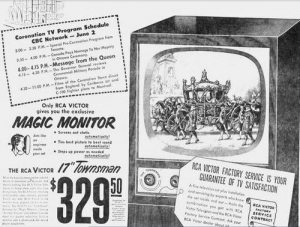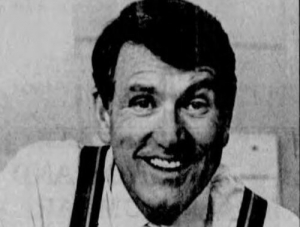Television Arrives in Ottawa
2 June 1953
By the late 1930s, commercial television broadcasting was ready for “prime time” after years of experimentation, first with mechanical systems and later with electronic systems. The British Broadcasting Corporation (BBC) is credited with the first “high-definition” television broadcast when it began regularly scheduled transmissions in late 1936 from its studios at the Alexandra Palace in London using Marconi-EMI’s fully electronic system. “High definition” in this context should not to be confused with today’s high-definition television. The BBC was broadcasting with just 405 lines of resolution, much less than the 720-1,080 lines considered to be high definition today. Its broadcast resolution was, however, far superior to that of earlier broadcasting systems that had resolutions ranging from roughly 30 to 204 lines. The BBC station’s range was officially only forty kilometres, though unofficially it could reach much farther depending on atmospheric conditions. BBC television quickly became a big hit; the hot, new gift in London during the 1937 Christmas season was the television set. Some 10,000 receivers were sold. But progress came to a halt at the outbreak of World War II when the BBC suspended its broadcasts owing to fears that German bombers could use its signal to home in onto London. BBC technicians were also needed elsewhere to support the war effort.
In North America, experimentation also went into high gear during the 1930s. The Canadian experimental station VE9EC, owned by La Presse and CKAC radio in Montreal, broadcasted during the early years of the decade using mechanical systems with 60-150 lines of resolution. In the United States, a number of competing broadcasting systems were also being tested and perfected. The Radio Corporation of America (RCA) began regular experimental television broadcasts in New York City in the spring of 1939, transmitting monochrome (i.e., black and white) programmes from the top of the Empire State Building. RCA’s television subsidiary became the National Broadcasting Corporation (NBC). That same year, RCA began to ramp up its production of television receivers for sale to the general public. RCA also demonstrated the television at the 1939 Canadian National Exposition in Toronto, marketing it as “science’s most modern miracle,” that will soon feature in every home. In 1940, the Columbia Broadcasting System (CBS) began regular black-and-white television broadcasting in the United States. In the spring of the following year, U.S. regulators adopted the 525-line resolution as the standard for the American television industry, allowing commercial television to move out of its experimental phase. However, like in Britain, the United States’ entry into the war delayed a wider roll-out of commercial television as vacuum tubes used in television sets were required for defence purposes.
With the war’s end in 1945, television took off in the United States. While initially confined to the major urban centres, the number of stations rose from 16 in 1948 to 354 by 1954. In 1947, 179,000 television sets were produced in the United States. By 1953, annual production was more than 7.2 million. This compares with only 2,000 receivers in use at the end of 1939.
Notwithstanding its success south of the border, television was slow to come to Canada. In 1947, senior Canadian Broadcasting Corporation (CBC) officials declared that “the time had not yet come for the general development of television on a sound basis in Canada.” Not surprisingly, given the burgeoning growth of U.S. television, there was criticism that CBC was dragging its feet. There were also fears that Canada was falling behind the United States and other competitors in the technology race. Two related and highly political issues were delaying television’s Canadian debut—ownership and funding. The big question was whether Canada should have a national, state-owned television network, similar to publicly-owned networks in Europe, which would promote Canadian values and culture, or allow private television networks, as in the United States, that might be foreign owned, and broadcast foreign shows. There was also considerable controversy about the cost of building a Canada-wide television network. The initial funding for CBC television was placed at $4.5 million (roughly $46 million today). Later, material shortages were also cited as delaying the building of stations, with expansion beyond Toronto and Montreal dependent on the defence production programme associated with the Korean War.
In part, the government’s hand was forced by US border stations whose signals could be picked up by Canadians living close to the U.S. border. In Ottawa, the signal from the NBC affiliate WSYR-TV from Syracuse, New York could be picked up from early September 1951. The Evening Citizen reported that a Mr Kitchen of 350 Chapel Street managed to receive a good video signal with his home-made antenna and three home-made boosters. Canadian television was finally born on 6 September 1952 when CBC’s Montreal station CBFT began regular programme broadcasts. Its Toronto station, CBLT, commenced broadcasting two days later.
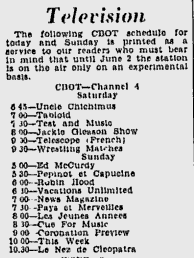 First programme listing for CBOT, The Ottawa Evening Citizen, 30 May 1953.Canadian television officially arrived in Ottawa at 2pm on 2 June 1953 when CBOT, the CBC’s third station, began regular broadcasting. Using equipment supplied by Marconi’s Wireless and Telegraph Company of Montreal, the station initially had a range of only 15 miles (24 kilometres). Its signal was later boosted to have a range of 40 miles (65 kilometres). Found on channel 4 on the television dial, CBOT actually started testing its equipment roughly two weeks earlier when a microwave relay tower built on the top of the Bell Telephone Building on O’Connor Street became operational. The microwave system, which could simultaneously carry both telephone and television signals, linked Ottawa to Toronto and Montreal. After test programmes were transmitted with “astonishing clarity” over the long May weekend, the station felt confident enough to list its programming schedule for Saturday, 30 May in the newspaper, albeit with a warning that it was still operating on an experimental basis. The station, which broadcasted for less than four hours that day, started at 6.45pm with Uncle Chichimus, the much beloved Toronto-based production starring John Conway and his two puppets, Uncle Chichimus and Hollyhock. The evening’s entertainment ended with an hour of wrestling starting at 9.30pm. During these early days of television, CBOT, like the Montreal station CBFT, offered programs in both English and French, a practice that continued until Radio Canada had its own stations. That first night’s French-language program was called Télescope.
First programme listing for CBOT, The Ottawa Evening Citizen, 30 May 1953.Canadian television officially arrived in Ottawa at 2pm on 2 June 1953 when CBOT, the CBC’s third station, began regular broadcasting. Using equipment supplied by Marconi’s Wireless and Telegraph Company of Montreal, the station initially had a range of only 15 miles (24 kilometres). Its signal was later boosted to have a range of 40 miles (65 kilometres). Found on channel 4 on the television dial, CBOT actually started testing its equipment roughly two weeks earlier when a microwave relay tower built on the top of the Bell Telephone Building on O’Connor Street became operational. The microwave system, which could simultaneously carry both telephone and television signals, linked Ottawa to Toronto and Montreal. After test programmes were transmitted with “astonishing clarity” over the long May weekend, the station felt confident enough to list its programming schedule for Saturday, 30 May in the newspaper, albeit with a warning that it was still operating on an experimental basis. The station, which broadcasted for less than four hours that day, started at 6.45pm with Uncle Chichimus, the much beloved Toronto-based production starring John Conway and his two puppets, Uncle Chichimus and Hollyhock. The evening’s entertainment ended with an hour of wrestling starting at 9.30pm. During these early days of television, CBOT, like the Montreal station CBFT, offered programs in both English and French, a practice that continued until Radio Canada had its own stations. That first night’s French-language program was called Télescope.
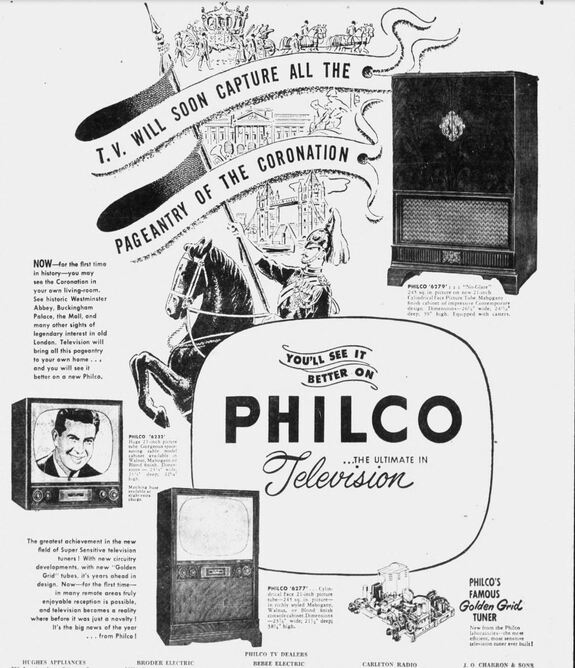 Ottawa Evening Citizen 28 May 1953.The official launch of CBOT on 2 June 1953 was timed to coincide with an event guaranteed to attract the largest audience possible—the Coronation of Queen Elizabeth II. Not only were celebratory events on Parliament Hill in Ottawa televised on the three CBC stations, but the entire Coronation ceremony from London with a delay of only four hours. In “Operation Pony Express,” three RAF Canberra bombers flew film footage across the Atlantic from North Weald Airport outside of London to Goose Bay, Newfoundland, with the first plane carrying the first two hours of film coverage, with the other two planes following with later hours of coverage. In Goose Bay, the film canisters were transferred onto RCAF CF-100 fighters for the flight to the St Hubert Airport outside of Montreal. A truck then took the film to the Radio Canada building in downtown Montreal for broadcasting, with simultaneous viewing in Montreal, Toronto, and Ottawa. Coverage of the Coronation from London started at 4.30pm, after a broadcast of the ceremonies on Parliament Hill, and the Queen’s Coronation message. Prior to the start of its Coronation coverage, CBC broadcasted a test pattern and music. Regular updates on the status of the Canberra flights were also provided. The Coronation broadcast was in black and white; colour programming would not be launched in Canada until 1966, thirteen years after colour was introduced in the United States. If people wanted to see the Coronation in colour, they had to go to the cinema when the film became available a few days later.
Ottawa Evening Citizen 28 May 1953.The official launch of CBOT on 2 June 1953 was timed to coincide with an event guaranteed to attract the largest audience possible—the Coronation of Queen Elizabeth II. Not only were celebratory events on Parliament Hill in Ottawa televised on the three CBC stations, but the entire Coronation ceremony from London with a delay of only four hours. In “Operation Pony Express,” three RAF Canberra bombers flew film footage across the Atlantic from North Weald Airport outside of London to Goose Bay, Newfoundland, with the first plane carrying the first two hours of film coverage, with the other two planes following with later hours of coverage. In Goose Bay, the film canisters were transferred onto RCAF CF-100 fighters for the flight to the St Hubert Airport outside of Montreal. A truck then took the film to the Radio Canada building in downtown Montreal for broadcasting, with simultaneous viewing in Montreal, Toronto, and Ottawa. Coverage of the Coronation from London started at 4.30pm, after a broadcast of the ceremonies on Parliament Hill, and the Queen’s Coronation message. Prior to the start of its Coronation coverage, CBC broadcasted a test pattern and music. Regular updates on the status of the Canberra flights were also provided. The Coronation broadcast was in black and white; colour programming would not be launched in Canada until 1966, thirteen years after colour was introduced in the United States. If people wanted to see the Coronation in colour, they had to go to the cinema when the film became available a few days later.
With the day declared a national holiday, people scrambled to find a television to watch the historic event. In Ottawa, the Radio and Television Manufacturers Association of Canada installed televisions in every school without charge to allow all students to watch the Coronation. An abridged French-language version was also televised. Naturally, parents were invited to watch as well–a good marketing ploy. Stores also offered special Coronation deals so that families could watch the events on their own sets. One enterprising store invited those uncertain about television, or were unable to afford a receiver (the price for the monochrome receiver started at $249.99, equivalent to $2,200 today), to come in and watch the Coronation on its sets for free.
From that day on, there was no looking back. Television quickly became, as RCA had predicted in 1939, an indispensable part of every Canadian household. In 1948, there were only 325 TV sets in Canada. In 1951, roughly one percent of Canadian households, mostly located in southern Ontario in range of American TV signals, had purchased a TV set. Ten years later, 83 per cent of Canadian households had a television, a higher percentage than that of homes with indoor plumbing.
Sources:
Canadian Communications Foundation, 2013. Television Station History, Ontario, Eastern Canada, CBOT-DT (CBC Nework), Ottawa, http://www.broadcasting-history.ca.
CBC-Radio Canada, 2015. Our History, http://www.cbc.radio-canada.ca/en/explore/our-history/.
CBC, 2015, “A TV Renaissance, TV In Canada, A History,” Doc Zone with Ann-Marie MacDonald, http://www.cbc.ca/doczone/features/tv-in-canada-a-history.
Freemeth, Howard, 2010, “Television,” Historica Canada, http://www.thecanadianencyclopedia.ca/en/article/television/.
Hammond Museum of Radio, 2004, “Some Dates From Canadian Broadcasting,” http://www.hammondmuseumofradio.org/dates.html.
TV History, 2013. Television History—The First 75 Years, Television Facts and Statistics—1939 to 2000, http://www.tvhistory.tv/facts-stats.htm.
The Evening Citizen, 1951. “Ottawans Get Good Video Reception,” 11 September.
————————, 1953. “Fly TV ‘Take’ To CBC: See Coronation Same Day Here,” 6 May.
————————, 1953. “Ottawa Microwave Radio Relay Tower In Operation on May 14th,” 6 May.
————————, 1953. “TV Sets To Be Installed In Schools For June 2,” 26 May.
————————, 1953. “Station CBOT Now On The Air Each Night,” 26 May.
————————, 1953. “Television,” 30 May 1953. The Globe and Mail, 1937. “Television Is London’s Newest Christmas Gift Idea,” 13 December.
————————, 1938. “10,000 Sets Made And Sold In United Kingdom,” 13 January.
————————, 1941. “Commercial Television Is Delayed By Defense,” 3 July.
————————, 1947. Television—Canada Not Ready, Says Frigon,” 28 June.
————————, 1949. “Ottawa Studies Loan in Millions for CBC Video,” 2 March.
————————, 1949. “Claims TV Delay Due To Ottawa Pre-Election Fears,” 3 May.
————————, 1951, “Hints Windsor, Ottawa, Quebec Next In Line For Canadian Television,” 16 November.
———————-, 1953. “Temporary Television Hookup To Let Ottawa See Coronation,” 13 March.
———————-, 1953. “Jets Bring Coronation Films For TV Viewers on Tuesday,” 30 May.
———————-, 2014. “Ferris-Wheel highs and nauseating lows from 135 years of the Ex,” 13 August.
Story written by James Powell, the author of the blog Today in Ottawa's History.
Retired from the Bank of Canada, James is the author or co-author of three books dealing with some aspect of Canadian history. These comprise: A History of the Canadian Dollar, 2005, Bank of Canada, The Bank of Canada of James Elliott Coyne: Challenges, Confrontation and Change,” 2009, Queen’s University Press, and with Jill Moxley, Faking It! A History of Counterfeiting in Canada, 2013, General Store Publishing House, Renfrew, Ontario. James is a Director of The Historical Society of Ottawa.
The Galloping Gourmet
30 December 1968
Long before Jamie Oliver or Gordon Ramsay worked their culinary magic on television, there was Graham Kerr, a.k.a. The Galloping Gourmet. While Kerr (pronounced “Care”) was not by any means the first gourmet chef to appear on the small screen—that honour goes to James Beard in 1946—he, like Julia Child, did much to popularize fine cooking in North America. At a time when the acme of fine dining for many Americans and Canadians was a hamburger topped with bacon and cheese, and Italian cuisine was a can of Chef Boyardee spaghetti, Kerr introduced millions to the likes of Lamb Apollo, Red Snapper in Pernod, Crab Captain Cook, and Gateau Saint Honoré. His zany antics, lightning fast wit and double entendres delivered while chopping and sautéing delighted television audiences around the world. At the peak of his popularity in 1970, his television show, The Galloping Gourmet, was seen in thirty-eight countries, including the United States, Canada, Britain, Germany, France and Australia, with more than 200 million viewers. Dubbed into French, it was called the Le Gourmet Farfelu on the CBC’s French-language network. Amazingly, The Galloping Gourmet was made in Ottawa.
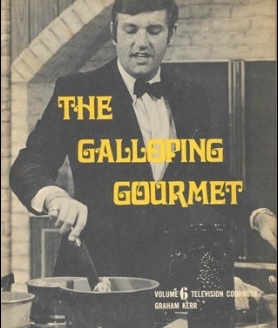 Graham Kerr - The Galloping Gourmet
Graham Kerr - The Galloping Gourmet
The Cooking ChannelThe British-born Kerr learnt how to cook as a teenager during the late 1940s in the kitchen of his parents’ hotel. After five years in the British Army’s catering corps, he moved to New Zealand and joined the New Zealand Air Force as a catering adviser. It was in New Zealand in 1959 that he got his first televised cooking show—Eggs with Flight Lieutenant Kerr. Performing in uniform, the young Kerr received a munificent $25 for his weekly television programme. Spotted by a promoter with links to Australia, Kerr was launched on Australian television with a programme called Entertaining with Kerr in 1964 on the Ten Network.
In 1968, he and his wife Treena came to Ottawa to film The Galloping Gourmet for Freemantle International, a television production/distribution company. Although the show was aimed at an American audience, the Kerrs chose Canada as their base of operations because they wanted to bring a British/Australian flavour to the show that they thought might be lost in an American-made production. Also, Canada had first class television studios that could make colour programmes. Colour television had been introduced to the Canadian market in 1966, whereas Australian television was still operating in black and white. To make the daily 23-minute programme, the Kerrs went to the CJOH studios located at the corner of Merivale Road and Clyde Avenue in Ottawa. Then owned by Bushnell Communications, CJOH was the third busiest television production centre in Canada. Under the direction of Bill McKee, an exceptional staff of 160 people, of whom 100 were directly in production, worked ten hour days seven days a week producing as many as dozen different television series as well as films for government departments. In a 1970 interview, Kerr stated that CJOH had the “finest” television crew with whom they had ever worked.
Production of The Galloping Gourmet began in the summer of 1968, making six shows a day, thirty shows per week. It was a gruelling schedule. The Kerrs worked as a team, Graham in front of the camera, and Treena as the show’s producer. Initially, there was little to distinguish the new show. Indeed, the television studio’s audience relations staff found it difficult to find people willing to fill the seats in the studio equipped with a full kitchen with an autumn brown fridge and stove, dining room, bar and wine rack. However, this was to quickly change.
The programme first aired on CBC television (CBOT, channel 4 in Ottawa) at 4pm on Monday, 30 December, 1968, up against the likes of Match Game, Big Spender, House Party, and the cartoon show Hercules. The show was also syndicated throughout the United States. CBOT advertised it as “a cooking show…but what a cooking show! It is as entertaining as the best comedy shows and as informative as a documentary because of the talent of the host Graham Kerr, a world famous gourmet, formerly of England, now living in Australia.” It added that Kerr was nicknamed the galloping gourmet, “because of the lightning speed at which he moves his six foot, three-inch frame while alternately singing, dancing, telling stories and giving homely advice…all while cooking sumptuous dishes with dazzling dexterity.”
It was an apt description though his nickname was more likely based on a book that he co-authored with wine expert Len Evans called The Galloping Gourmets published in 1967. The book chronicled the authors’ globetrotting efforts to find the world’s best restaurants in 35 days. His address was also wrong. By this time, Graham, Treena and the Kerr children had taken up residence in the tony Rockcliffe Park neighbourhood in Ottawa.
The Galloping Gourmet was an instant and huge success though some stations censored the more naughty bits. The Globe and Mail, in a rant about the poor quality of daytime television filled with Lucy Show and Gilligan’s Island re-runs, soap operas, and second-rate talk shows, likened The Galloping Gourmet to “a flower growing in a crammed wall.” It opined that “while Graham gallops, there is hope.” Tickets to attend the show’s tapings became as rare as hen’s teeth. Kerr’s most faithful admirers were female. One die-hard fan attended 49 times during the show’s first year. It helped that he was a culinary James Bond with a sense of humour—young, good looking, always impeccably dressed, and a superb British accent.
photoBut the show appealed to all, women and men, young and old. The reason—it was fun. Each show began with Kerr jumping over a chair with a glass of wine in his hand. The manoeuvre, suggested by wife Treena, became his signature move. Most shows had some gag that were sure to provoke guffaws, such as stirring a pot with a five-foot spoon called “Big Mouth,” or pulling a brassiere out of a rolling pin. Shows also featured clips of exciting places around the world visited by the Kerrs for culinary inspiration. But the most endearing feature of the show was Kerr’s unbounded enthusiasm, excellent comic timing, and an ability to roll with whatever happened. To watch him try to unstick a reluctant cake out of a mould while a cherry sauce is cooking on the stove is hysterically funny. The show was nominated for two Daytime Emmys, but lost out to The Today Show. However, Kerr received the ultimate public recognition when he was invited to appear on The Tonight Show with Johnny Carson in 1970.
But what about the food? Kerr’s culinary critics poo-pooed his skills, seeing him as a showman rather than an expert at fine cuisine. One called him the Liberace of the cooking world. There may be an element of truth to this. But he introduced people to a range of cuisines from Cajun jambalaya and British beer and rump pot roast to Mexican huevos rancheros and Russian shrimp povlik. One thing that was clear, however, his food was rich…very rich. There were few vegetables. In his recipes, Kerr used copious amounts of clarified butter, fat and sugar. Just watching him lard an already well-marbled, two-inch steak, then fry it in butter, bacon fat and brown sugar is sufficient to clog the arteries. But this was a more innocent time. Certainly, willing volunteers, usually women pulled from the audience at the end of each show to taste his culinary creations, appeared to love his food.
At the height of his popularity, disaster struck. In April 1971, Kerr was seriously hurt when a truck rear-ended his car in California, leaving him with a damaged spine and a weakened right arm. The couple returned to Ottawa to try to tape another season, but things were not the same. With Kerr injured, shows were mostly cobbled together using bits of earlier programmes with celebrities brought in to give their opinions of past shows and dishes. In the summer of that year, the Kerrs bade Ottawa good bye after taping 560 shows in front of 46,000 people. He lauded Ottawans for their support, coming out for tapings in the midst of snowstorms, and stoically sitting through an overheated studio when summer air conditioning failed.
From leafy Rockcliffe, the family charted a new course aboard their $300,000, 71-foot yacht with an aim to visit the world’s beauty spots while they recuperated and worked on new projects, including a Galloping Gourmet line of kitchens, cook books, and cooking utensils. But things didn’t turn out as expected. Treena was diagnosed with terminal lung cancer. Fortunately, the diagnosis proved to be wrong; it turned out to be tuberculosis. But she still lost part of a lung and became hooked on both prescription and non-prescription drugs. They also lost $800,000 to a man they had trusted. The couple subsequently became born-again Christians and abjured their earlier lives. Turning his back on the galloping gourmet, Kerr gave up alcohol, which had featured prominently in his earlier shows, and his risqué behaviour. The couple visited Ottawa in 1975 to appear at an evangelical rally at the Earl Armstrong Arena in Gloucester. The same year, Kerr returned to television hosting Take Kerr, a five-minute, syndicated cooking show featuring a mix of alcohol-free recipes with a dash of Christianity.
In 1987, Treena suffered a stroke and heart attack exacerbated husband Graham was convinced by his high fat, high sugar recipes of earlier years. In response, he re-doubled his efforts to create healthy “minmax” recipes—minimum fat and cholesterol with maximum flavour and aroma. More television shows, including The Graham Kerr Show, made in Seattle, Washington, and cook books that emphasized wholesome foods followed. In 1997, Kerr returned to Canada, this time to the Bay’s Arcadian Court in Toronto to tape yet another cooking programme called Graham Kerr’s Gathering Place.
Treena Keer died in September 2015 just short of their 60th wedding anniversary. Graham Keer, who turned 85 in January 2017 lives in Mount Vernon in Skaget County, near Seattle. Today, Keer has come to terms with his galloping gourmet past. His latest passion is “upstreaming,” that he describes as the “conversion of habits that can harm” into “resources that can heal” ourselves and the planet. Reruns of The Galloping Gourmet can be seen occasionally on late night television or on the Cooking Channel. Some have also been posted on YouTube. They are worth watching for the Sixties clothes and hairstyles, and, of course, for Graham Kerr’s incomparable cooking style and humour.
Sources:
Chicago Tribune (The), 1972. “A Glimpse of Graham, the Gourmet,” 9 November.
Goldman, Jeanette, 2015. The Galloping Gourmet (Graham Kerr) “The Monty Python of Cooking.
Kerr, Graham, 2017. Time to Grow.
Levine, Sarah, 20?. “Devour the Blog: Loving: The Galloping Gourmet,” Cooking Channel, 21 May.
Ottawa Journal, (The), 1968. “CBOT Highlights,” 28 December.
————————–, 1969. “A Watched Nockerln,” 30 April.
————————–, 1970. “The Galloping Gourmet in Moscow,” 7 February.
————————–, 1970. “Graham Loves Us,” 8 August.
————————–, 1971. “The Galloping Gourmet goes, salutes ‘fabulous’ Ottawans,” 23 August.
————————–, 1972. “Battle of the Sexes Name of the Game,” 11 March.
————————–, 1972. “Galloping Gourmet hungers for the sea,” 19 July.
————————–, 1974. “Ottawa TV production centre is one of Canada’s busiest,” 21 December.
————————–, 1975. “Galloping Gourmet has come up with a recipe for a good life after his recent conversion,” 23 August.
World Library, 2017. The Galloping Gourmet
Images:
Ottawa Citizen, November 18, 1992. p.54.
The Galloping Gourmet, Volume 6 Television Cookbook.



